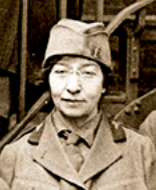Olga Povitzky
Olga Raissa Povitzky (December 24, 1877 – May 21, 1948), also seen as Olga Povitsky, was a Russian-born American physician and bacteriologist with the New York Health Department; she also worked at a field hospital in France during World War I.
Early life and education
Olga Povitzky was born in Lithuania, then part of the Russian Empire. She moved to the United States in 1893[1] to live with her brother Charles, who was a druggist in Philadelphia.[2] Her sister Anna Pavitt Boudin became a prominent dentist in New York.[3] Her niece, Eleanor Osborne-Hill, was a lawyer and sculptor.[4]
Povitzky graduated from the Woman's Medical College of Pennsylvania in 1901; she and her fellow graduate, Dora Chatterjee, were highlighted in news reports of the graduation.[5][6] In 1905, she completed a doctorate in public health at New York University.[7]
Career
Povitzky was a bacteriologist for the New York Health Department for almost forty years, beginning in 1910.[8][9] In 1914, she joined Anna Wessels Williams for a study of trachoma in New York City schoolchildren.[10] During World War I, she went to France to serve in a women-run field hospital, organized as the Women's Medical Unit for Foreign Service and sponsored by the National American Woman Suffrage Association (NAWSA).[11][12] While in France, she received specialized training at the Pasteur Institute, in the treatment of gas gangrene; she also worked at a laboratory in Le Mans.[7]
Back in New York, Povitzky worked on diphtheria antitoxin production. In 1923, she collaborated with Josephine Neal in developing a serum to cure meningitis, in a health department laboratory at Willard Parker Hospital.[13] She published her research in academic journals, including Science,[14] Archives of Internal Medicine,[15] The Journal of Infectious Diseases,[16] Journal of Immunology,[17][18] Experimental Biology and Medicine,[19] and American Journal of Public Health.[20] She also lectured on public health topics.[7]
Povitzky designed the Povitzky Bottle, a flat-sided Pyrex glass vessel used for culturing poliovirus.[7][21]
Publications
- "Agglutination in Pertussis" (1916, with Edward Worth)[15]
- "The Complement Fixation Reactions of the Bordet-Gengou Bacillus" (1916, with Miriam P. Olmstead)[22]
- "Prompt Macroscopic Agglutination in the Diagnosis of Glanders" (1918)[17]
- "Growth of B. Influenzae without the Presence of Hemoglobin" (1921, with Anna W. Williams)[23]
- "Improved Methods for the Isolation and Later Cultivation of B. Pertussis" (1923)[16]
- "Diphtheria toxin-antitoxin titration by Ramon method for practical application" (1924, with Edwin J. Banzhaf)[19]
- "Diphtheria Toxoid. Preparation and Dosage" (1931, with Minnie Eisner and Erla Jackson)[18]
- "Predominant Strain of B. influenzae in Influenzal Meningitis" (1933)[14]
- "Effectiveness of Standard Diphtheria Antitoxin Against all Types of Diphtheria Infection" (1933, with Minnie Eisner and Erla Jackson)[24]
- "The Effect of Temperature on the Antigenic Value of Diphtheria Toxoid" (1935, with Minnie Eisner)[25]
- "Standardization and Application of Different Preparations of Diphtheria Toxoid" (1936)[20]
Personal life
Povitzky became a United States citizen in 1904.[7] She died in 1948, in Moores Mill, Pleasant Valley, New York, aged 71 years.[26]
References
- ^ Birth date and date of arrival in United States are both found on Povitzky's Petition for Naturalization, granted in 1904; via Fold3
- ^ "Port Arthur Man Talks of Far East". Republican and Herald. 1904-04-28. p. 2. Retrieved 2021-12-23 – via Newspapers.com.
- ISSN 0362-4331. Retrieved 2021-12-23.
- ISSN 0362-4331. Retrieved 2021-12-23.
- ^ "Fair Graduates in Medicine. Hindoo Princess and Russian Belle Will Get Diplomas". The Owensboro Messenger. 1901-05-31. p. 4. Retrieved 2021-12-23 – via Newspapers.com.
- ^ "Graduates from Medical College". The Weekly Republican. 1901-07-11. p. 4. Retrieved 2021-12-23 – via Newspapers.com.
- ^ a b c d e Emrich, John, and Charles Richter (April 2020). "Hidden Figures of AAI: Five Women Pioneers in Immunology" The American Association of Immunologists.
- ^ "Department of Health" The City Record (Supplement): 482.
- ^ "Board of Health" (PDF). The City Record. June 20, 1927. p. 6515.
- JSTOR 30073381.
- ISSN 0362-4331. Retrieved 2021-12-23.
- ^ Beck, Melinda (4 March 2021). "Why Suffragists Helped Send Women Doctors to WWI's Front Lines". HISTORY. Retrieved 2021-12-23.
- ^ "Flu Meningitis Cure Discovered by Women". The Herald Democrat. March 31, 1923. p. 1. Retrieved December 23, 2021 – via Colorado Historic Newspapers Collection.
- ^ S2CID 239875584.
- ^ ISSN 0730-188X.
- ^ ISSN 0022-1899.
- ^ ISSN 0022-1767.
- ^ S2CID 70474188.
- ^ S2CID 102201643.
- ^ PMID 18014467.
- ^ Rutty, Christopher J. "TWK Povitsky Bottle 1950s". Health, Art, and Humanities Program, University of Toronto. Retrieved 2021-12-23.
- PMID 19972274.
- PMID 19972550.
- ISSN 0022-1899.
- ISSN 0022-1767.
- ISSN 0362-4331. Retrieved 2021-12-23.
External links
- A letter from Olga Povitzky to Martha Tracy (February 28, 1938), in the collection of Drexel University

